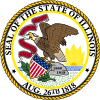| Lieutenant Governor of Illinois | |
|---|---|
 | |
since January 14, 2019 | |
| Government of Illinois | |
| Term length | 4 years, no term limits |
| Inaugural holder | Pierre Menard |
| Formation | 1818 |
| Salary | $139,200[1] |
| Website | www2 |
The lieutenant governor of Illinois is the second highest executive of the State of Illinois. In Illinois, the lieutenant governor and governor run on a joint ticket and are directly elected by popular vote. Gubernatorial candidates select their running mates when filing for office and appear on the primary election ballot together. When the governor of Illinois becomes unable to discharge the duties of that office, the lieutenant governor becomes acting governor. If the governor dies, resigns or is removed from office, the lieutenant governor becomes governor.[2][3] Under the Illinois Constitution, the Attorney General is next in line of succession to the Governor's office after the lieutenant governor, but does not succeed to the lieutenant governor's office. From the impeachment of Rod Blagojevich in 2009, until the inauguration of Sheila Simon in 2011, Attorney General Lisa Madigan would have become governor if Pat Quinn had vacated the office. Historically, the lieutenant governor has been from either the Democratic Party or Republican Party. The current lieutenant governor is Democrat Juliana Stratton.
Prior to the 1970 Constitution, governors and lieutenant governors were separately elected.[4] The 1970 Constitution introduced joint elections for governor and lieutenant governor, though the candidates were nominated in separate primaries. Following the 1986 and 2010 elections, in which the Democratic nominees for Governor were forced to run with extreme or disfavored lieutenant-gubernatorial nominees, the Illinois General Assembly abolished the separate-primary requirement.[5] The 2014 gubernatorial election was the first one to take place in which gubernatorial and lieutenant gubernatorial candidates ran on the same ticket in the primary election.
- ^ "The Book of the States | 2021 | Volume 53 by the Council of State Governments - Issuu". 7 January 2022.
- ^ "Constitution of the State of Illinois". Illinois General Assembly. Retrieved August 22, 2019.
- ^ "Illinois Compiled Statutes 15 ILCS 5 — Governor Succession Act". Illinois General Assembly. Retrieved August 23, 2019.
- ^ Yeargain, T. Quinn (2021). "One Vote, Two Winners: Team-Ticket Gubernatorial Elections and the Need for Further Reform". University of Miami Law Review. 75 (3): 377–78. Retrieved October 15, 2022.
- ^ Yeargain 2021, p. 779, 782-83, 794.
